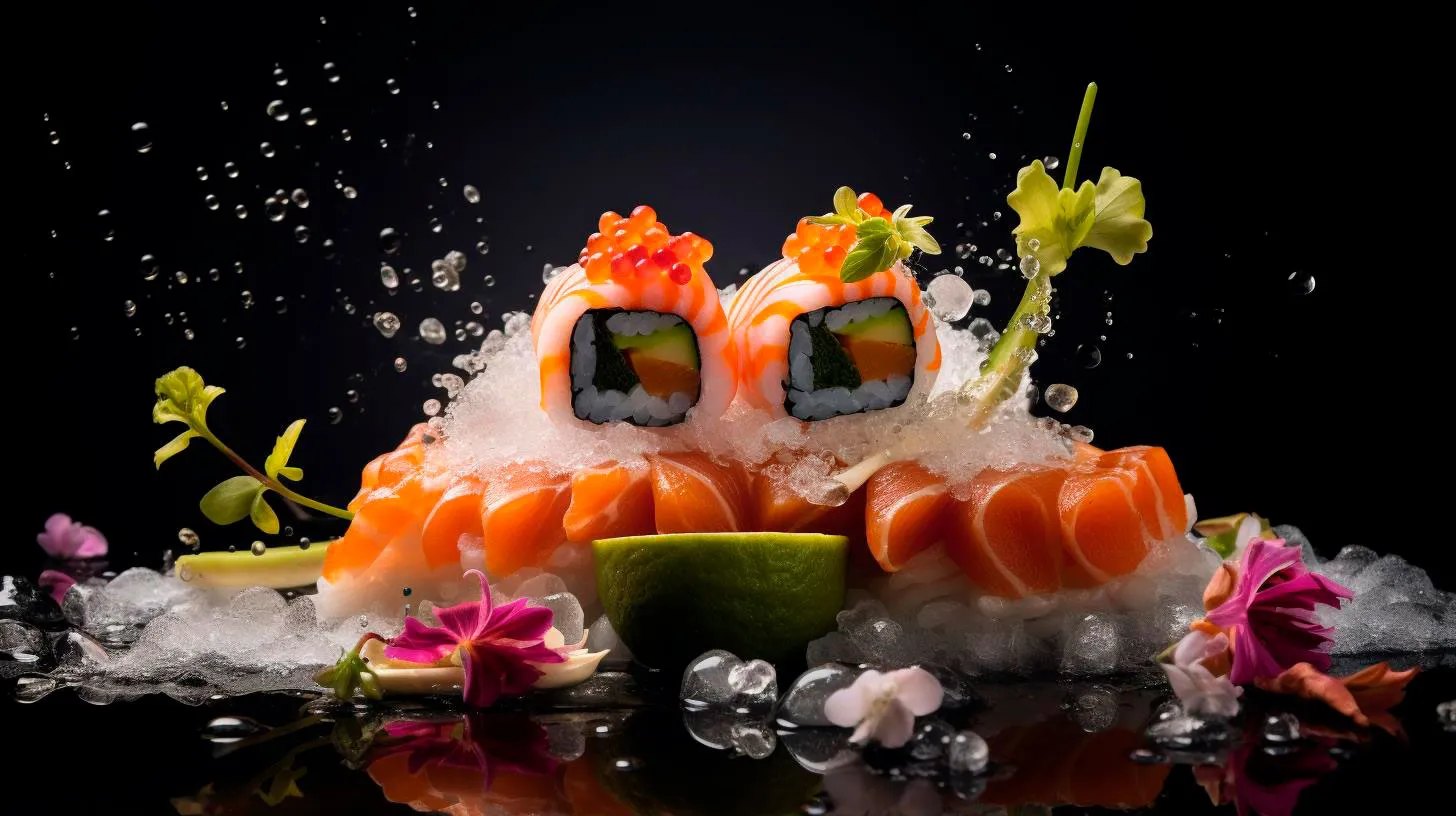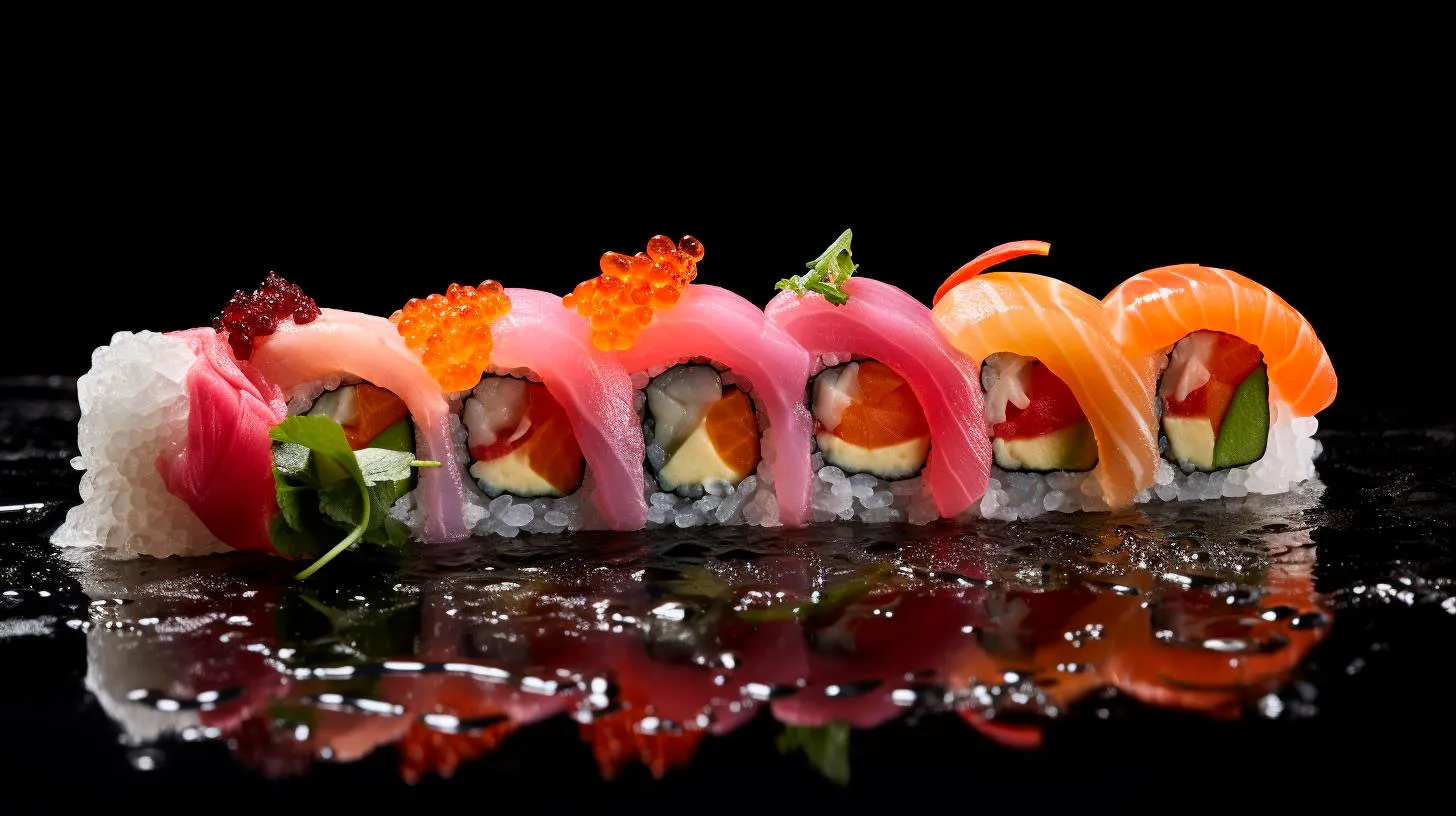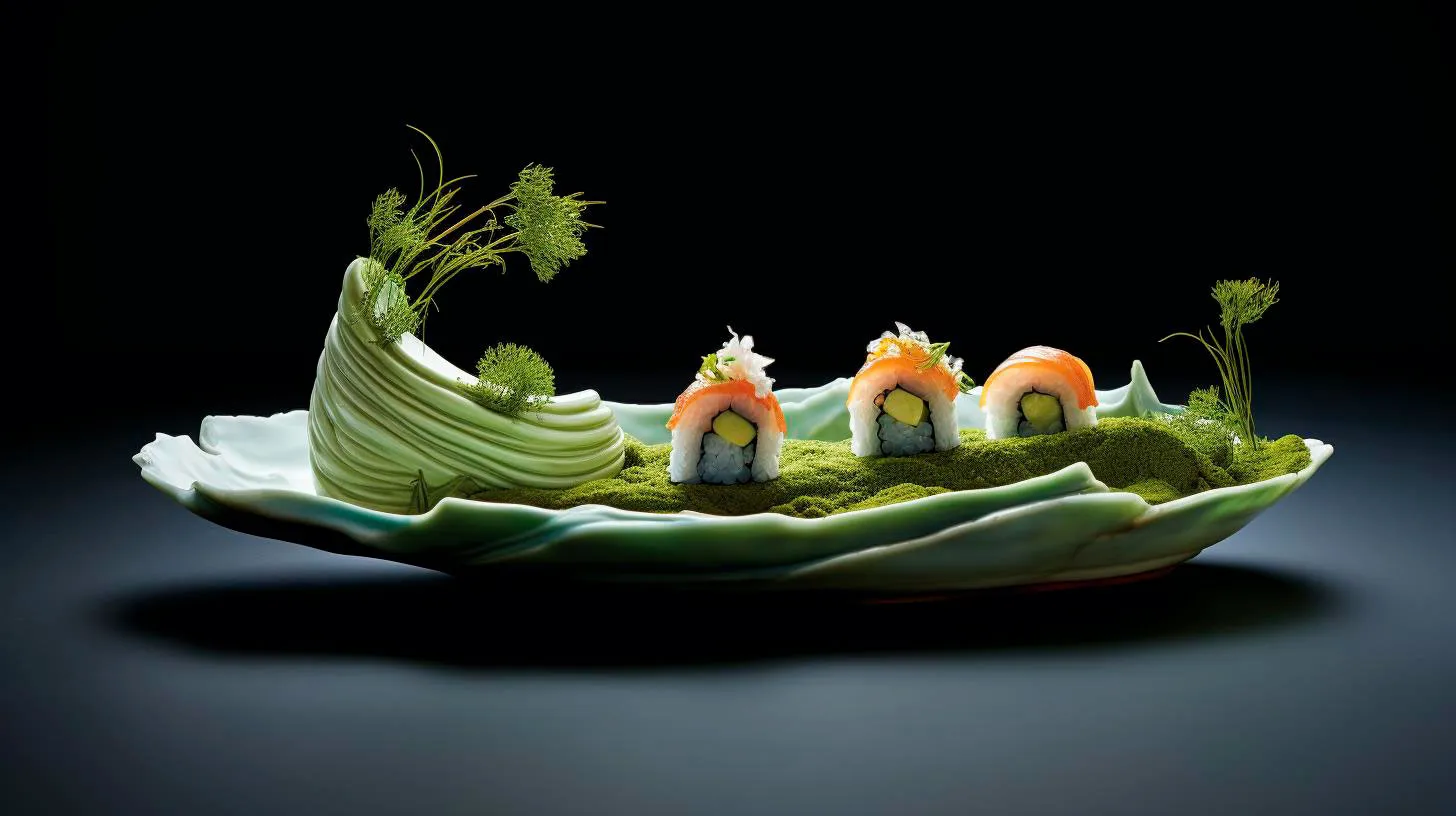Exploring the Art of Nori Wrapping: Elevating Sushi Roll Presentation
In this article, we will delve into the secrets of Nori wrapping and explore how it can elevate sushi roll presentation to new heights.
The Basics of Nori Wrapping
Nori wrapping involves carefully handling and shaping the delicate seaweed sheet to encase the rice and fillings of a sushi roll seamlessly. The process requires precision and attention to detail to create visually appealing and structurally sound rolls. Mastering the art of Nori wrapping allows sushi chefs to showcase their creativity and skills.
Key Takeaways:
- The art of Nori wrapping enhances the visual appeal of sushi rolls.
- Precision and attention to detail are crucial for successful Nori wrapping.
- Mastering Nori wrapping allows sushi chefs to showcase their creativity.
Benefits of Nori Wrapping
1. Improved Texture: Nori wrapping adds a pleasing texture to sushi rolls. The crispiness of the seaweed sheet contrasts with the softness of the rice and fillings, enhancing the overall mouthfeel.
2. Flavour Enhancement: Nori has a distinct umami flavor that complements the flavors of the sushi roll. It adds a subtle saltiness and depth of taste, enhancing the overall flavor profile.
3. Structural Integrity: Proper Nori wrapping ensures that the sushi roll holds together, preventing it from falling apart during consumption. This allows for a more enjoyable dining experience.
4. Visual Appeal: Nori wrapping adds an element of visual excitement to sushi rolls. Intricate designs, patterns, and colors created with the Nori sheet can turn a simple roll into a stunning culinary masterpiece.
Key Takeaways:
- Nori wrapping enhances the texture and flavor of sushi rolls.
- It provides structural integrity, preventing the roll from falling apart.
- Nori wrapping adds visual appeal with intricate designs and patterns.
Techniques for Nori Wrapping
There are various techniques sushi chefs employ when it comes to Nori wrapping. Here are three popular methods:
1. Standard Wrap: The most common method involves placing the Nori sheet on a sushi mat, covering it with a thin layer of rice, and adding the desired fillings. The sushi mat is then used to roll the ingredients tightly. The Nori sheet adheres to the roll, creating a seamless finish.
2. Inside-Out Roll: In this technique, the rice is spread directly on the Nori sheet, leaving a small border at the top. The sheet is then flipped so that the rice is on the outside, and the fillings are added. The sushi mat is used to roll the ingredients tightly, ensuring the Nori wraps around the roll neatly.
3. Patterned Wrap: For a visually striking presentation, sushi chefs create intricate designs and patterns using Nori sheets. These designs can range from traditional motifs to custom designs inspired by various themes. The patterned Nori is then used to wrap the sushi roll, elevating its visual appeal.
Key Takeaways:
- The standard wrap is the most commonly used Nori wrapping technique.
- Inside-Out rolls involve flipping the Nori sheet after placing the rice.
- Patterned wraps allow for visually striking sushi roll presentations.
Statistics on Nori Wrapping
1. According to a survey conducted among sushi lovers, 78% of respondents stated that the visual presentation of sushi rolls influenced their decision to order.
2. In a study of sushi restaurants, it was found that 65% of customers were more likely to take pictures of intricately Nori-wrapped sushi rolls and share them on social media.
3. A recent trend report revealed that sushi rolls with patterned Nori wrapping saw a 35% increase in popularity in the past year.
In Conclusion
Nori wrapping is not just a technique; it is an art form that allows sushi chefs to elevate the presentation of sushi rolls. The art of Nori wrapping enhances the texture, flavor, and visual appeal of the dish, creating an unforgettable dining experience. By mastering different Nori wrapping techniques and experimenting with intricate designs, sushi chefs can unleash their creativity and captivate sushi lovers worldwide.
So next time you indulge in sushi, appreciate the mastery behind the Nori wrapping and let it transport you to a world where culinary artistry meets delicious flavors.
Nori Wrapper Innovations: How Chefs are Reinventing Sushi Rolls
In this article, we will explore the innovative ways chefs are reinventing sushi rolls by experimenting with new nori wrapper variations and revolutionizing traditional techniques.
The Rise of Nori Wrapper Innovations
Sushi rolls have traditionally been wrapped in nori, which lends a unique umami flavor and a slightly crispy texture to the overall dish. The nori wrapper acts as a vessel, holding together the various ingredients while providing an enjoyable eating experience. However, as chefs embrace creativity and strive to offer unique dining experiences, they have begun to experiment with alternative nori wrapper options. These innovations have not only captivated sushi enthusiasts but have also opened new avenues for culinary exploration.
1. Alternative Seaweed Wrappers
While nori remains a popular choice, chefs have started incorporating other seaweed varieties, such as kombu and dulse, as alternatives to wrap their sushi rolls. These unique wrappers bring distinctive flavors and textures to the dish, adding a layer of complexity and excitement. Kombu, for instance, offers a slightly sweeter and more delicate taste, while dulse imparts a briny, smoky flavor.
- Feature: Alternative seaweed wrappers provide new flavor profiles and experiences.
- Advantage: Expands the range of options for sushi enthusiasts with diverse preferences.
- Key Takeaway: Chefs can use various seaweed wrappers to create exciting and innovative sushi roll combinations.
2. Vegetable Wrappers
Creating sushi rolls without using seaweed wrappers altogether has become another trend among chefs. Instead, they have turned to vegetables like cucumber, radish, and even thinly sliced sweet potatoes to encase their sushi ingredients. These vegetable wrappers not only add vibrant colors to the rolls but also offer a refreshing and crunchy texture.
- Feature: Vegetable wrappers bring a refreshing twist to traditional sushi rolls.
- Advantage: Provides a lighter and healthier option for those looking to reduce their seaweed intake.
- Key Takeaway: Chefs can get creative by using various vegetables as wrappers, enhancing the visual appeal and taste of their sushi rolls.
3. Soy Paper Wraps
Soy paper, derived from soybeans, has gained popularity as an alternative to traditional nori wrappers. This thin and delicate wrap is available in different colors, allowing chefs to infuse their sushi rolls with a visually stunning aesthetic. Additionally, soy paper has a subtle flavor that complements a variety of sushi fillings.
- Feature: Soy paper wraps offer versatility in presentation, thanks to various color options.
- Advantage: Appeals to diners who prefer a milder taste and those with dietary restrictions.
- Key Takeaway: Chefs can use soy paper wraps to create visually captivating sushi rolls with unique flavor combinations.
Embracing Innovation: Key Takeaways
Innovation is at the heart of any culinary evolution, and sushi rolls are no exception. The creative use of alternative nori wrappers has revolutionized sushi culture, providing chefs with countless possibilities to experiment with flavors, textures, and presentations. Here are the key takeaways:
- Alternative seaweed wrappers expand the flavor profiles and choices for sushi enthusiasts.
- Vegetable wrappers offer a lighter and healthier option, while adding vibrancy and crunch.
- Soy paper wraps provide versatility in presentation, appealing to a wider audience.
As sushi continues to captivate diners around the world, these nori wrapper innovations demonstrate the ever-evolving nature of culinary arts. By reinventing sushi rolls with new wrappers, chefs are pushing the boundaries of tradition, creating exciting and memorable dining experiences for sushi lovers everywhere.
Nori Wraps: A Versatile Ingredient in Modern Sushi Creations
The Role of Nori Wraps in Sushi
Nori wraps serve as a fundamental ingredient in sushi, providing a savory flavor and acting as a vessel to hold the sushi filling together. Traditionally, nori wraps were used in maki sushi, where the rice, fish, and vegetables are rolled tightly in a sheet of nori.
However, as sushi evolved and reached international popularity, chefs started experimenting with different presentations and flavors. This led to the creation of innovative sushi styles like hand rolls and sushi burritos, where nori wraps are wrapped loosely around the fillings, allowing for a more customized experience.
Benefits of Nori Wraps
- Rich in nutrients: Nori wraps are packed with essential vitamins and minerals, including iodine, vitamin C, and iron. They are also a good source of dietary fiber and protein.
- Low in calories: Nori wraps are incredibly low in calories, making them a healthy choice for those striving to maintain a balanced diet.
- Umami flavor: Nori wraps contribute a distinct umami flavor to sushi, elevating the taste profile of the dish. Umami, often described as the fifth taste, adds a savory and satisfying element.
- High in antioxidants: Nori wraps are rich in antioxidants, which are known for their ability to combat oxidative stress and promote overall well-being.
Exploring Modern Sushi Creations
The use of nori wraps in sushi extends far beyond the traditional maki rolls. Let’s explore some of the modern sushi creations where nori wraps shine:
California Rolls
California rolls, one of the most popular variations of sushi worldwide, feature a tantalizing combination of crab, avocado, and cucumber wrapped in a nori sheet. This innovative creation was initially developed to address certain cultural and ingredient limitations, as true sushi-grade fish was not readily available in the United States. Today, it has become a sushi staple and a gateway for many sushi enthusiasts.
Hand Rolls
Hand rolls, also known as temaki, are a hit among sushi lovers. These cone-shaped delights offer a customizable experience, allowing diners to choose their preferred fillings. A sheet of nori is wrapped around a handful of rice, fresh fish, vegetables, and other delectable toppings. The beauty of hand rolls lies in their simplicity, providing a burst of flavors and textures in every bite.
Sushi Burritos
The fusion of Japanese and Mexican cuisines gave birth to yet another sushi creation – the sushi burrito. This delightful marriage of flavors and styles combines the exciting elements of a sushi roll with the convenience of a handheld burrito. Nori wraps play a vital role in keeping all the delicious fillings intact, ensuring that each bite delivers a harmonious blend of flavors.
Conclusion
Nori wraps have revolutionized the world of sushi, enabling chefs and home cooks alike to create a myriad of visually stunning and flavorful creations. Beyond their use in traditional maki rolls, nori wraps have paved the way for inventive sushi styles like California rolls, hand rolls, and sushi burritos. With their nutrient-rich composition, low calorie count, and unique umami flavor, nori wraps are truly a versatile ingredient that deserves the spotlight in modern sushi creations.
So, the next time you indulge in a sushi feast, pay attention to the nori wraps that hold it all together. Embrace the umami goodness, relish the diverse textures, and embark on a culinary journey that celebrates the incredible versatility of nori wraps in sushi.
The Evolution of Nori Wrappers in Sushi Cuisine
Over the years, the evolution of nori wrappers has shaped the way we enjoy this traditional Japanese cuisine.
A Brief History of Nori Wrappers
Nori, a type of edible seaweed, has been a staple in Japanese cuisine for centuries. Its origins can be traced back to ancient China, where dried seaweed was used to wrap food for preservation. Eventually, this technique made its way to Japan, where it became an integral part of sushi making.
In the early days, nori was primarily used for its preserving qualities rather than for taste. It was often used to wrap fish and rice to keep them fresh. However, as sushi gained popularity during the Edo period in Japan (1603-1868), so did the use of nori as a wrapper.
The Traditional Use of Nori Wrappers
Traditionally, sushi was made by fermenting fish with rice and wrapping it with nori. The fermentation process was time-consuming and required careful monitoring to ensure food safety. During this period, the taste of nori was not as predominant, as the focus was more on the fermentation process and the flavor of the sushi filling itself.
As the years went by, sushi evolved, and new techniques emerged. The use of fresh fish instead of fermented fish became more popular, and the focus shifted towards enhancing the overall flavor of the sushi. This also brought a change in the role of nori wrappers, as they started to contribute more to the taste and texture of the dish.
The Modern Twist
In recent years, sushi chefs have embraced new methods and innovations in their craft. This has led to exciting modifications in sushi presentation and flavor, with nori wrappers playing a significant role.
Today, sushi chefs get creative with nori, infusing it with flavors like wasabi or sesame to add an extra kick to the sushi rolls. Some chefs even experiment with alternative ingredients like soybean paper or cucumber slices to replace traditional nori and offer unique taste experiences.
Moreover, technological advancements have further revolutionized nori production. The cultivation, harvesting, and processing techniques have evolved, resulting in higher quality nori wrappers. With improved packaging and storage methods, the freshness and crunchiness of nori are better preserved.
Key Takeaways
- The history of nori wrappers can be traced back to ancient China.
- Sushi gained popularity during Japan’s Edo period, leading to the use of nori as a wrapper.
- Initially, nori was primarily used for preservation rather than taste.
- Modern sushi techniques focus on enhancing the overall flavor and appearance of sushi.
- Nori wrappers have evolved to include infused flavors and alternative ingredients.
- Technological advancements have improved the cultivation and processing of nori.
The evolution of nori wrappers has undoubtedly transformed the way we enjoy sushi. From a preserving agent to a flavor enhancer, nori has come a long way. Sushi lovers can now experience a variety of tastes and textures, thanks to the innovations in sushi-making techniques.
As the world continues to embrace sushi cuisine, it is fascinating to witness how this traditional Japanese dish evolves with time. The versatility of nori wrappers allows sushi chefs to experiment and create new flavors, ensuring that sushi remains a timeless favorite for generations to come.



